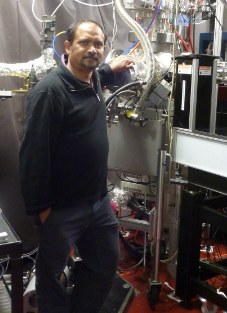 In his 19 years at the ALS, senior scientist Musa Ahmed has seen chemistry grow from a somewhat obscure synchrotron science focus area to a cornerstone, award-winning ALS program. Ahmed was recently charged with leading the chemical sciences program for both ALS chemical dynamics beamlines, 9.0.1 and 11.0.2, which befits his long-standing enthusiasm and leadership in advancing chemistry research at the ALS.
In his 19 years at the ALS, senior scientist Musa Ahmed has seen chemistry grow from a somewhat obscure synchrotron science focus area to a cornerstone, award-winning ALS program. Ahmed was recently charged with leading the chemical sciences program for both ALS chemical dynamics beamlines, 9.0.1 and 11.0.2, which befits his long-standing enthusiasm and leadership in advancing chemistry research at the ALS.
“Our hallmark for the last 20 years has been fundamental chemical physics,” says Ahmed. “We do chemistry with a very big C, focusing on building up our knowledge base.”
The two chemical dynamics beamlines cover a broad range of science, including combustion, environmental chemistry, energy science, astrochemistry and astrophysics, fundamental chemical physics, and chemical dynamics. From biofuels to soot formation, the facilities and capabilities available at Beamlines 9.0.2 and 11.0.2 give scientists at molecular-level understanding of fundamental chemical processes. Ahmed notes that both the 2011 and 2012 David Shirley Awards for Outstanding Scientific Achievement at the ALS went to chemical dynamics beamline scientists, a testament to the excellence of the program.
Ahmed’s own research focus is on understanding and mapping the physical and chemical principles that govern complicated phenomena in nature. “My goal is to gain a molecular-level understanding of alternative carbon neutral energy sources and global climate change using imaging and biological mass spectrometry, atmospheric and environmental chemistry, and dynamics of combustion processes,” he says.
Ahmed’s scope reaches beyond the two beamlines in his latest endeavor, which is to create an umbrella group focused on chemistry at the ALS in general. He hopes it will be an opportunity for collaboration among beamline scientists and users from around the ring. Recent LDRD funding will also allow Ahmed to push the chemical science beamlines beyond the static regime into probe dynamics and more laser synchrotron experiments. Beamline 9.0.2 will soon gain some extra space, as BL 9.0.1 is moving, which will give Ahmed and his group greater flexibility in the layout of their many roll-out endstations.
“I’ve stayed at the ALS all this time because I feel I’ve been able to help create a unique research environment that other synchrotrons actually try to emulate, and the ALS has allowed this to evolve,” says Ahmed. “There’s also a lot of intellectual satisfaction in working with a beamline that produces some of the brightest vacuum ultraviolet photons in the world.”